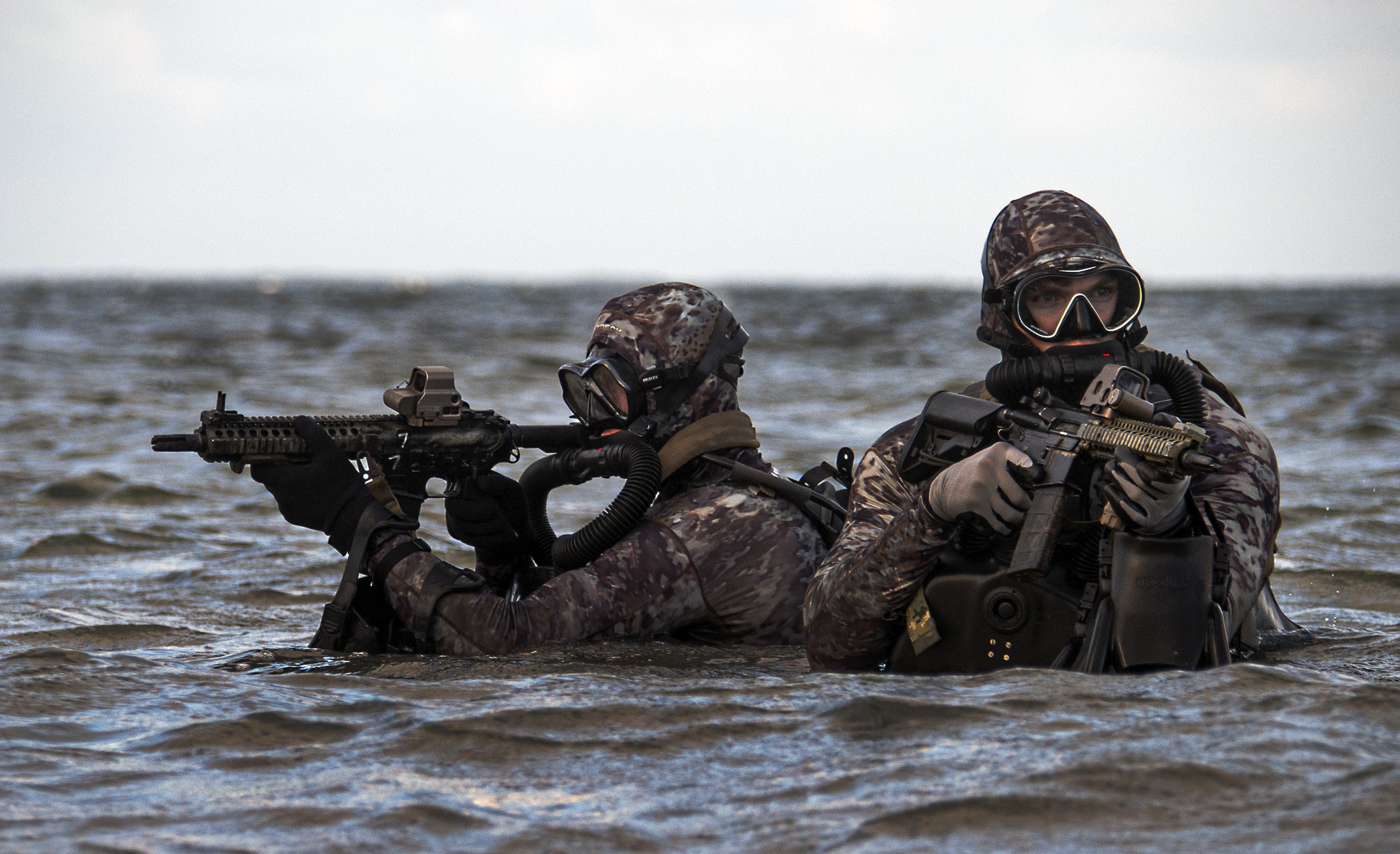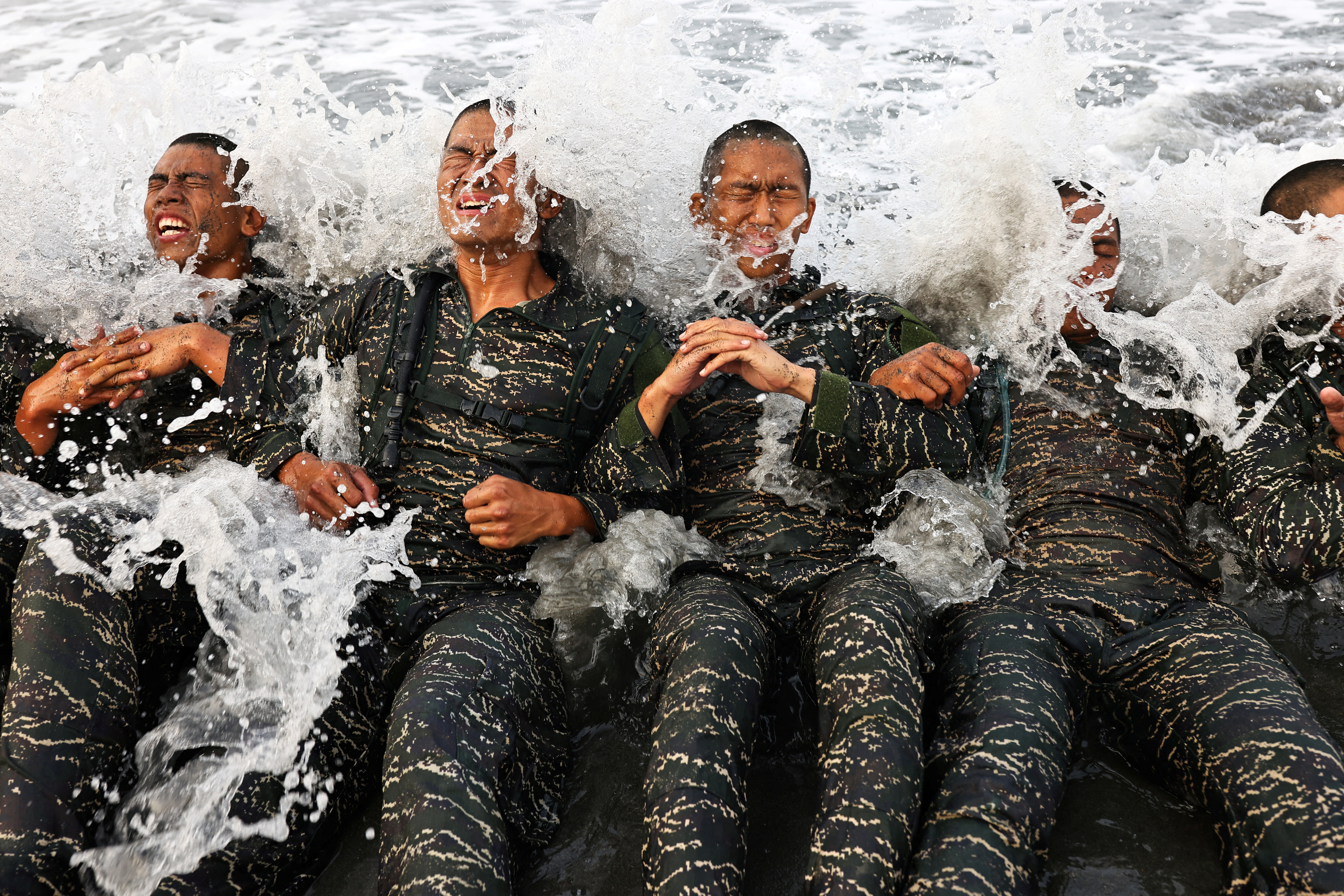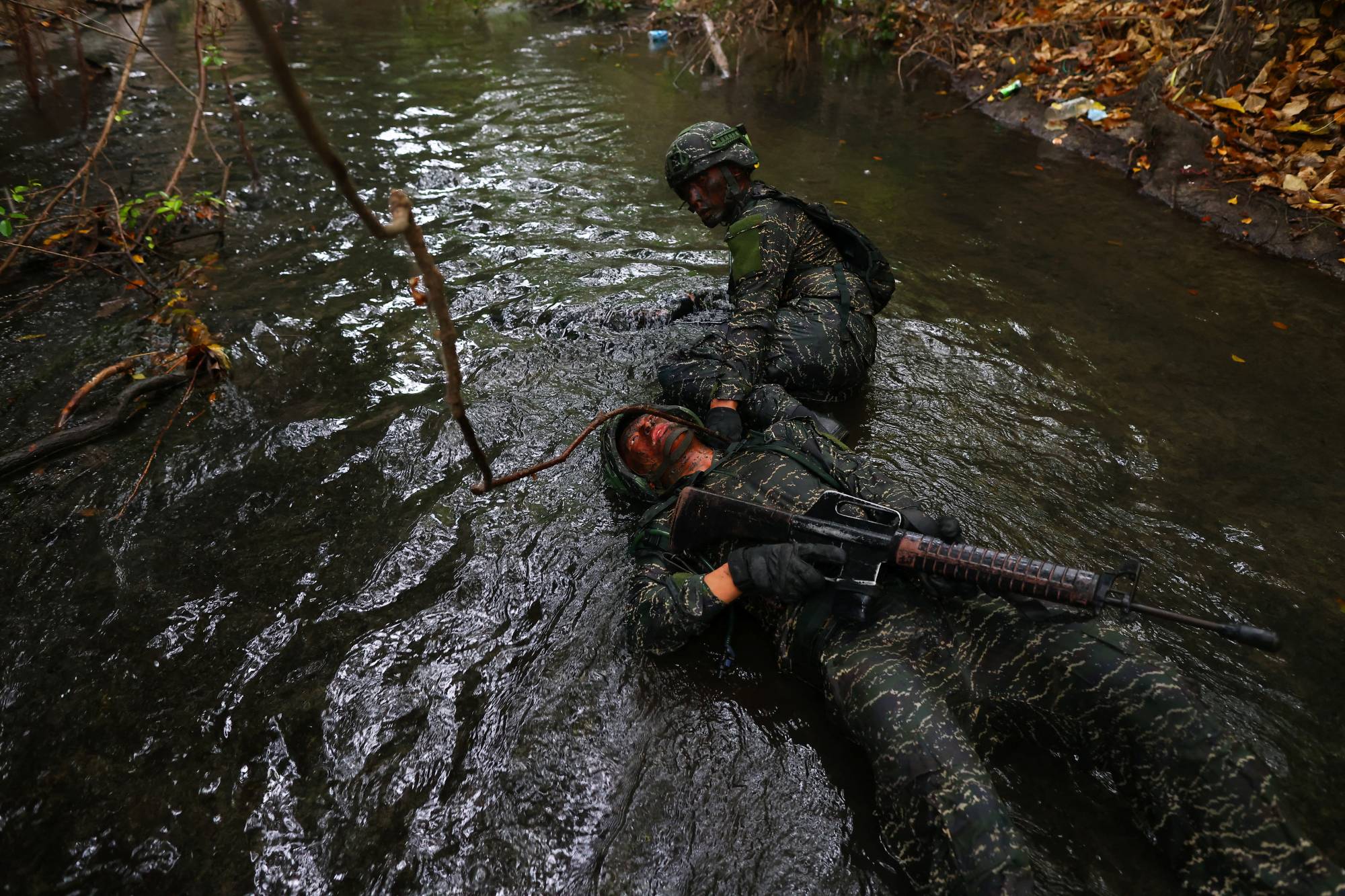Military Frogmen - A SEAL delivery team member boards a delivery vehicle before launching from the stern of the submarine USS Philadelphia.
A diver is a person trained in the tactical skills of scuba diving or underwater swimming employed by the military and, in some European countries, the police. Such personnel are also known by the more formal names of combat divers, combat divers, or combat swimmers. The word frogman first appeared in Paul Boyton's stage name The Fearless Frogman in 1870.
Military Frogmen

And John Space, later an enlisted member of the US Navy and a member of the OSS Marine Unit, claimed it was applied to him while he was training in a gray waterproof suit.
Alfashirt Danish Frogman Corps Coat Type Ii Danish Frogmen Military Marine Unit Black
The term frogman is sometimes used for a civilian scuba diver. Some sport diving clubs include the word frogm in their name.
But the frogman epithet continues in informal use by non-divers, particularly in the media, and often refers to professional scuba divers, such as in the role of police diver.
In the US military and intelligence community, divers trained in scuba or CCUBA who deploy for tactical attack missions are called "combat divers".
The term is commonly used for Navy UDTs, Navy SEALs, Navy SARCs, and Navy Explosive Ordnance Disposal (EOD) units. The Navy SWCC has a heritage of combat swimming rather than diving, being one of the few and very elite trained in this element. Other frog units include Marine Raider Marine Recon, US Army Special Forces (aka Gray Berets) combat divers, Army Ranger Regimental Reconnaissance Company, Air Force Pararescue, Air Force Combat Controller, and Air Force Special Reconnaissance, as well as operatives. CIA Special Activities Ctr.
Pergelator: March Of The Frogmen
Some countries' strategic diving organizations have incorporated translations of the word frogman into their official names, such as Dmark's Fromandscorpset; Others call themselves "combat divers" or similar. Others call themselves by vague names like "Special Group 13" and "Special Operations Unit".
Tactical diving is a branch of professional diving practiced by armed forces and tactical units. They can be divided into:
These groups may overlap, and may serve as the same m attack divers and operational divers, such as the Australian Clearance Diving Branch (RAN).

Typically, a diver with closed-circuit oxygen rebreathing equipment stays at a depth of 20 feet (6.1 m) and limits deep excursions to a maximum of 50 feet (15 m) because of the risk of acute oxygen poisoning.
Original Wwii Underwater Demolition Team 7 Named Frogman Grouping With Bronze Star Citation
The use of nitrox or mixed gas rebreathers can significantly increase this depth range, but depending on the unit, may be out of range of operation.
Acts which the enemy may know but the perpetrators cannot be easily detected or apprehended. Covert operations often involve military force that cannot be concealed once it occurs. Quiet on approach, and often on departure, can be used.
It is intended that Amy does not know that action has been taken - for example, installing eavesdropping devices. Access, installation of equipment, and departure are all maintained by Amy's knowledge. If the operation or its purpose is exposed, the actor will usually ensure that the operation remains at least "secret", or inappropriate.
Anti-frogman techniques are protective mechanisms developed to protect ships, ports and installations, and other sensitive resources from potential threats or intrusion by frogs in or near vulnerable waterways.
Joytoy Source 1/18 Marine Corp Frogmen
Frogs use rebreathers in covert operations, as bubbles emitted by open-circuit scuba expose them to surface lookouts and make sounds easily detected by hydrophones.
A 1945 British Navy Frogman, with Davies apparatus, a rebreather originally conceived by Robert Davies in 1910 as an emergency submarine escape set.
In ancient Roman and Greek times, there were examples of m swimming or diving for battle, sometimes using hollow plant stems or long bones as snorkels. Snorkel diving was introduced by Aristotle (4th century BC).

The earliest description of frogs in battle is found in Thucydides' History of the Peloponnesian War. The first occurred in 425 BC, when the Athenian fleet besieged the Spartans on the small island of Spectria. The Spartans managed to get supplies from the mainland by having underwater swimmers tow submerged sacks of supplies. In another incident of the same war, in 415 BC the Athenians used war divers in the port of Syracuse in Sicily. The Syracuses built vertical wooden piers at the bottom of their harbor to prevent Athenian triremes from capsizing. The poles were submerged, not visible above sea level. The Athenians used a variety of tools to cut through these obstacles, including divers with saws.
File:navy Paskal Frogman Strike Team Personnels With Hk Weapons During 57th Ndp.jpg
It is assumed that underwater saws require a snorkel to breathe and that the weight of the dive is necessary to stabilize divers.
In addition, al-Maqrizi's writings also claim that the naval forces of the Fatimid caliphs were defeated in an encounter with Byzantine forces off the coast of Messina, known as the Battle of the Straits, and adopted a new strategy. Similarities to the movements of modern day frogs. In the writings of Heinz Hallam, who studied and translated the writings of al-Maqrizi and other contemporary Islamic historians, it is described: "They dived from their own ships and swam to the Ami ship; which had Greek vessels of fire. The Ami made a move toward the ship, and were smashed on the sternpost. Apparently , this tactic contributed to the destruction of many Byzantine ships. It was successful, and the battle resulted in a major Fatimid victory; according to Arab historians, there were a thousand prisoners. The Byzantine admiral, Niketas, along with many of his officers, was taken, as well as a heavy Indian sword that any There was an inscription indicating that the time belonged to Muhammad.
The Hungarian Chronicle Pictum claims that the 1052 invasion of Hungary III was defeated by a skilled diver who destroyed the Hungarian supply fleet. The sudden sinking of the ship is confirmed by German history.
Italy began World War II with a pre-trained commando frogman force. During World War II, Britain, Germany, the United States, and the Soviet Union introduced commando frogman forces.
Frogmen Don't Leap Into A Helicopter, They Use A Rope Ladder
The term frogman first appeared in the stage name The Fearless Frogman of Paul Boyton, who broke long-distance swimming records from the 1870s by displaying a newly invented rubber immersion suit with an inflated hood.
The first modern frogs were the World War II Italian commando frogs of the Decima Flottiglia MAS (now "ComSubIn": Comando Raggruppamto Subacquei e Incursori Teseo Tesei), built in 1938 and first entered into action in 1940. Originally these divers were called "Gminio". Because they were members of a top secret special unit called "Grupo Gamma", which originated from a type of Pirelli rubber skin-suit.
The nickname used by these divers is Muta Gama. They were later nicknamed "Umini Rana," Italian for "frog m" because of the frog kick style of swimming underwater, similar to that of a frog, or because their fins looked like frog legs.

This particular core used the early oxygen rebreather scuba set, the Autorespirator ad Osego (ARO), the dredger oxygen self-contained breathing apparatus designed for the mining industry, and the Davies submersible developed by Siebe, Gorman & Company. equipment. and designed by Bergomi to survive submerged submarines. It was used for spear fishing by Italian sport divers from the 1920s, modified and adapted for use in protected waters by Italian naval gunners and manufactured by Pirelli and Salvas from about 1933, and thus modernized. Became the forerunner of the diving rebreather.
Us Navy Dog Tags Us Navy Seal Frogman Frogmen Warfare Devgru Military Navy Unisex Long Sleeve Sweatshirt All Over Print
For this new method of underwater diving, Italian frogmen were trained in La Spezia, Liguria, using the newly available Gois free diving spearfishing equipment. Diving masks, snorkels, swimfins and rubber dry suits, the first purpose-built diving watch (Luminsect Panerai), and the new ARO. Scuba unit.
It was a revolutionary alternative method of diving, and began the transition from heavy underwater diving equipment to hard hat divers, common since the 18th century, to self-contained divers, untethered by one. Air line and rope connection.
After Italy's declaration of war, the Decima Flotiglia MAS (Xª MAS) attempted several frog raids on British naval bases in the Mediterranean between June 1940 and July 1941, but none were successful, either due to equipment failure or as early detection by British forces. On September 10, 1941, eight Xª MAS frogmen boarded a submarine near the British port of Gibraltar, where, using manned torpedoes, three merchant ships were sunk before leaving neutral Spain. Another successful attack, the Raid on Alexandria, was mounted on 19 December in the harbor of Alexandria, again using manned torpedoes. HMS Que Elizabeth and HMS Valiant were disabled along with one destroyer and one oil tanker during the raid, but all six Frogs were captured.
Frogum was deployed by stealth to Algeciras, Spain, from where she launched several limpet-mine attacks on Allied shipping at anchor near Gibraltar.
Indian Army Para Sf Frogman Unit, Responsible For Underwater Covert Operations, Armed With Iwi Tavor Tar 21 With Mars Red Dot Sights, Fab Defense Mod Aks With Bel Holographic Sight, And Diver Propulsion
After a while they refitted the intern Italian
Military drone range, laser range finder military, military range bags, military range targets, long range military radio, military radio range, military range finder, military long range binoculars, range rover military discount, military range rover, range of military drones, military range bag
0 Comments